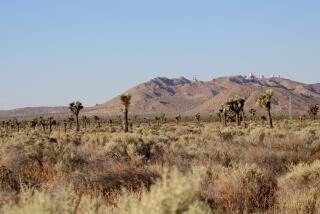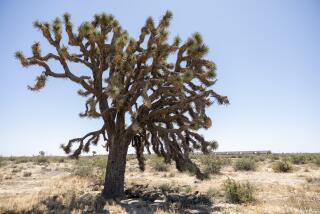Israel Voice of America Station Opposed
JERUSALEM — Israeli environmentalists are trying to stop a huge Voice of America transmission station planned for the Negev Desert, saying it will endanger birds and wildlife and ruin a unique landscape.
“Millions of birds from Europe funnel through this area to Africa every year,” said Joseph Shadur, a spokesman for the Society for the Protection of Nature in Israel. “They are an essential part of the environment and they will be physically hurt by the transmitters.”
The U.S. government intends the station to transmit Voice of America and Radio Liberty programs to Eastern Europe, Central Asia and Africa in 28 languages.
Critics question whether the United States still needs to broadcast propaganda now that the Cold War is over.
The station--now in the final stage of approval--will be one of the most powerful shortwave broadcast stations in the world, with 16 500-kilowatt transmitters and 37 curtain antennas that will occupy three square miles of land just south of the Dead Sea. Several antennas will be 650 feet high.
Israel agreed to provide a site in 1987, motivated largely by a feeling of indebtedness toward its closest ally and economic benefactor.
Reuven Yerador, director of the state company in charge of building the station, quoted an Israeli official involved in the decision as saying: “Considering the number of favors we ask of the Americans, when they finally ask us for something, we would need some good reasons to say no.”
Washington gives Israel $3 billion annually in economic and military aid and frequently defends the Jewish state in international forums.
But Israeli environmentalists say there are some compelling reasons to call off the project, despite the possible damage to relations with the United States.
Their first concern is the damage that may be done to birds.
The Arava Valley, part of what is known as the Syrian-African rift, is one of the chief migration routes for more than 5 billion birds flying between Africa and Europe, ornithologist Ron Frumkin said.
“Thousands of birds flying over the station could crash into antennas or land on them and burn to death,” Frumkin said. “Many others could lose their way due to the effects of electromagnetic radiation on their navigation mechanisms.”
If birds do not reach their migration grounds in Europe, the balance of nature could be seriously upset, he said.
In addition to large flocks of storks, pelicans and herons that fly over the Negev Desert and the Arava Valley, the world’s entire population of certain species--such as Levant sparrow hawks and honey buzzards--pass through the area, he said.
Yerador, however, said much of the concern over the birds was based on misinformation.
As evidence he presented a map prepared by the Israeli Air Force and the nature society charting bird migration routes to help pilots avoid collisions. It shows no routes going directly over the site of the station.
Frumkin said the map charted only the main route and many of the tens of thousands of birds that fly in its margins would pass over the planned station. A wind change could divert the whole flock to that area, he added.
Local farmers are another concern. They are threatening to leave because they fear radiation from the transmitters, casting doubt on government hopes that the station will boost the area’s economy.
But Yerador said radiation levels will conform with international safety standards and be lower than emissions from some of Israel’s existing radio transmitters.
Israelis are also concerned that the station will close a popular Negev hiking area, which includes an ancient spice trail, Nabatean ruins and unique wildlife.
The Air Force may have to reposition one of its training areas there because, nearer the station, transmissions could interfere with planes’ sensitive avionics.
The last remaining hurdle to construction is final approval by the National Building and Planning Committee, but the nature society believes the project can still be stopped.
More to Read
Sign up for Essential California
The most important California stories and recommendations in your inbox every morning.
You may occasionally receive promotional content from the Los Angeles Times.










